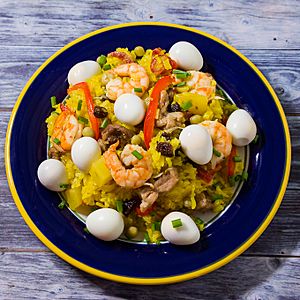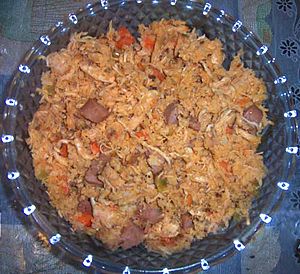Arroz a la valenciana facts for kids

Filipino-style arroz a la valenciana
|
|
| Alternative names | Arroz à valenciana, Arroz valenciana |
|---|---|
| Course | Meal |
| Place of origin | Latin America, Philippines (ultimately from Valencian Community, |
| Main ingredients | rice · saffron, annatto or turmeric to color · seafood · meats · vegetables |
Arroz a la valenciana (which means Valencian-style rice) is a popular rice dish. It comes from the Valencian Community in eastern Spain. Many countries around the world have their own versions of this tasty meal.
This dish is like a cousin to the famous paella. Both come from old ways of cooking rice in Valencia. People in places like Argentina, Colombia, Cuba, and the Philippines have been making their own Arroz a la valenciana for a long time. In the Philippines, they even call it arosbalensiyana.
Even though there are many ways to make it, most Arroz a la valenciana dishes are dry (not soupy). They often get their bright color from spices like saffron. You'll also usually find vegetables, meats, and seafood in them.
Contents
History of Valencian Rice
Rice was likely grown in Valencia even before the Moorish people arrived. But it was the Arabs who really helped grow more rice and find new ways to use it. Old cookbooks show that people were already adding saffron to their rice back then.
Over time, cooking rice became very important in Valencia. Many new recipes appeared, adding vegetables and meats. During the time of the Spanish colonies, Arroz a la valenciana spread far and wide. It traveled to places like Nicaragua and the Philippines. People in these new places changed the recipe to fit their local ingredients and tastes.
The first time Arroz a la valenciana was written down was in the 1700s. A monk named Josep Orri mentioned it in his cooking notes. Later, in 1780, another monk published a cookbook in Mexico City that included the recipe. An old Mexican cookbook from 1836 even had a recipe for Arroz a la valenciana with green chiles and saffron. The dish also showed up in a cookbook from Havana in 1862.
In the late 1800s, people started using the name arroz a la paella (meaning 'rice in a frying pan') to describe Arroz a la valenciana. In 1903, a famous French chef, Auguste Escoffier, wrote about riz valenciennes in his cookbook. This shows how well-known the dish had become!
Arroz a la Valenciana vs. Paella Valenciana
Many people use the names Arroz a la valenciana and paella as if they are the same. In a way, paella can be seen as a special kind of Arroz a la valenciana.
The main difference is that real Valencian paella has only 10 specific ingredients. These are lima beans, tomato, Ferraúra beans, chicken, rabbit, salt, olive oil, round rice, water, and saffron. A Valencian chef named Rafael Vidal confirmed these ingredients in 2000. The Valencian Government also agrees with this list.
On the other hand, Arroz a la valenciana is more like a whole group of recipes. It's a general way to cook rice, allowing for many different ingredients.
Arroz a la Valenciana Around the World
Bolivian Style
In Bolivia, Arroz a la valenciana is a very popular dish. It often has chicken, and sometimes chorizo sausage. It also includes many vegetables like peas, onion, tomatoes, green beans, carrots, and local potatoes. The rice gets its color from paprika or saffron, and red chili pepper gives it a bit of a kick!
Chilean Style
The Chilean way of making Arroz a la valenciana often uses curry or turmeric to color the rice. Sometimes, they still use saffron, like in the original Spanish recipe. People sometimes call it "Chilean paella." It usually has lots of seafood, such as clams, shrimp, and Chilean mussels. You can also add sausages or chicken. If it only has vegetables, it's called "Arroz a la Jardinera."
Colombian Style
In Colombia, Arroz a la valenciana is a common dish, especially near the coast. It usually has pork or chicken, along with fish and seafood. It is mostly seasoned with saffron.
Filipino Style
In the Philippines, Arroz a la valenciana (called aros balensiyana in Tagalog) is sometimes called the "paella of the poor." It's made with a local sticky rice called malagkit. The vegetables can change depending on the place, but it usually has onion and pepper. This version also uses coconut milk.
It's common to add alcohol to the dish, like white wine or beer. They might also use butter instead of oil. It often includes pieces of chicken and sometimes a local sausage called Bilbao sausage.
Marianas Islands Style
The recipe for Arroz a la valenciana traveled to the Mariana Islands in the Pacific during the Spanish colonial times. The local people, called chamorros, know it as balensiåna. They color it with a spice called achiote.
Nicaraguan Style
The Nicaraguan recipe for Arroz a la Valenciana is different from the Spanish original. It uses butter instead of oil, and includes onion, tomato sauce, sweet pepper (called chiltoma), and other vegetables. For meat, it usually has chicken, ham, or small sausages. It's a popular rice dish in Nicaragua and is sometimes called "Arroz de piñata" because it's often made for celebrations. It's usually cooked with beer or white wine.
Portuguese Style
Arroz à valenciana is found all over Portugal. It can have many types of meat, like chicken, pork, or sausages. It also includes seafood or squid, and different vegetables like peas and red peppers. The rice gets its color from saffron. Another common spice in this version is garlic. White wine is often added too.
Salvadoran Style
In El Salvador, Arroz a la valenciana often includes hard-boiled eggs and chicken pieces like breast, gizzard, or liver. Many vegetables are added, such as onion, peas, sweet corn, or carrots. For spices, people commonly use curry or paprika.
See also
 In Spanish: Arroz a la valenciana para niños
In Spanish: Arroz a la valenciana para niños



